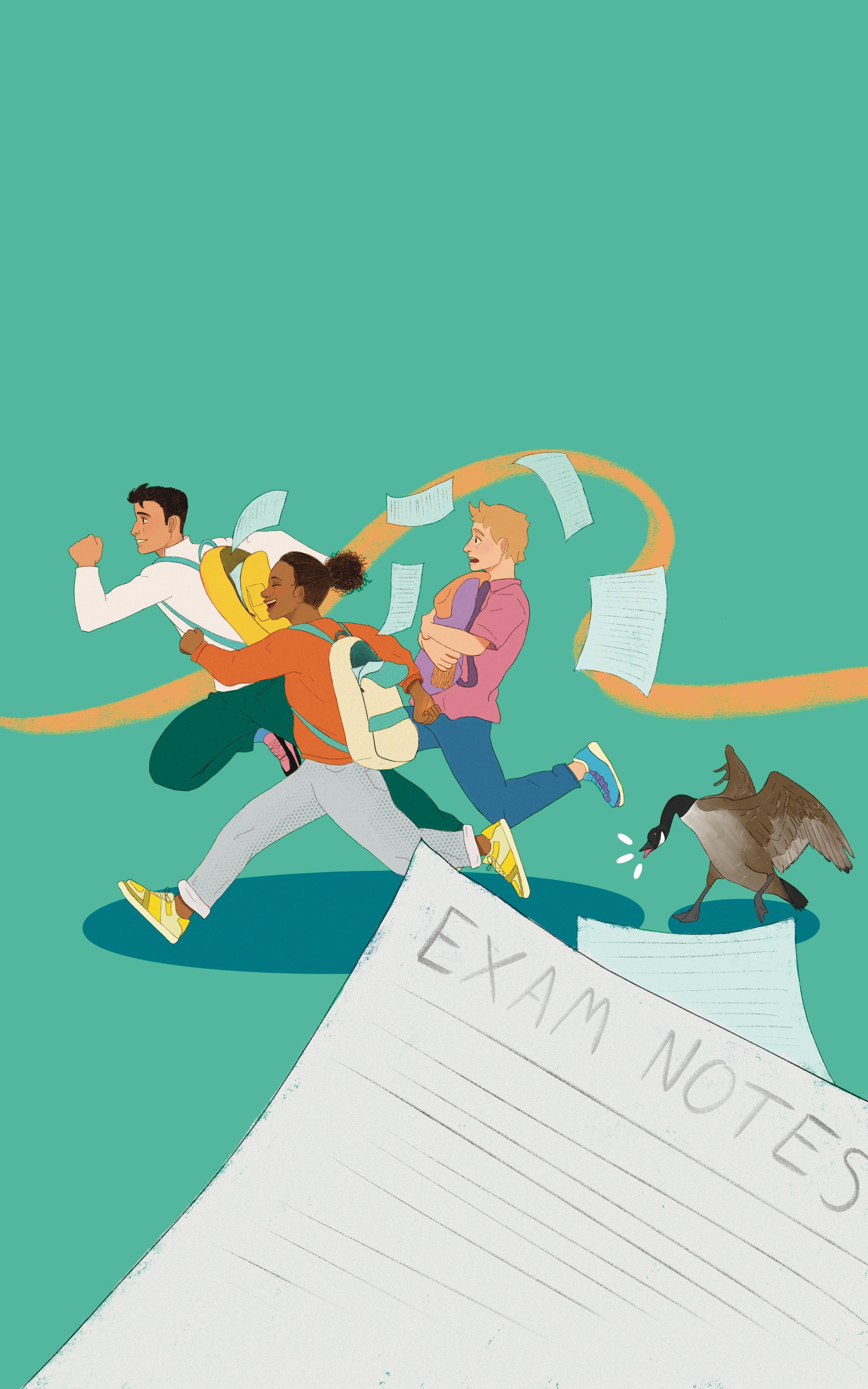
April 10, 2024 VOl . 110, NO. 29 SiNCE 1914

THEMANITOBAN.COM
109 HELEN GLASS BUILDING
UNIVERSITY OF MANITOBA
WINNIPEG, MB
204. 474. 6535
The Manitoban is the official student newspaper of the University of Manitoba. It is published monthly during the summer and each week of regular classes during the academic year by the Manitoban Newspaper Publications Corporation.
The Manitoban is an independent and democratic student organization, open to participation from all students. It exists to serve its readers as students and citizens.
The Manitoban is a member of the Canadian University Press, and our journalistic standards can be found on the Manitoban’s website.
The newspaper’s primary mandate is to report fairly and objectively on issues and events of importance and interest to the students of the University of Manitoba, to provide an open forum for the free expression and exchange of opinions and ideas and to stimulate meaningful debate on issues that affect or would otherwise be of interest to the student body and/ or society in general. The Manitoban serves as a training ground for students interested in any aspect of journalism.




graphics@themanitoban.com
Students and other interested parties are invited to contribute to any section of the newspaper. Please contact the appropriate editor for submission guidelines.
The Manitoban reserves the right to edit all submissions and will not publish any material deemed by its Editorial Board to be discriminatory, racist, sexist, homophobic or transphobic, ableist or libellous.
expressed in letters and articles
those of the authors.



year
Manitoban.
as
in accordance
Manitoban Constitution.
contents are ©2024 and may not be reprinted without the express written permission of the Editor-in-Chief. 2 Vol. 110 No. 29 EDITOR-IN-CHIEF Gillian Brown editor@themanitoban.com BUSINESS MANAGER Alice Teufack accounts@themanitoban.com ADVERTISING CO-ORDINATOR Diego Castro ads@themanitoban.com EDITORIAL MANAGING EDITOR vacant me@themanitoban.com
EDITOR
ASSOCIATE
NEWS EDITOR
news@themanitoban.com
EDITOR
McKillop news@themanitoban.com RESEARCH & TECHNOLOGY EDITOR Elah Ajene research@themanitoban.com COMMENT EDITOR Jessie Krahn comment@themanitoban.com ARTS & CULTURE EDITOR Jacob Davis arts@themanitoban.com SPORTS EDITOR Joshua Brandt sports@themanitoban.com DESIGN DESIGN EDITOR Taeran An design@themanitoban.com DESIGN ASSOCIATE Deveney Jarrow GRAPHICS EDITOR Teegan Gillich
Opinions
are solely
Editorials in the Manitoban are signed and represent the opinions of the writer(s), not necessarily those of the Manitoban staff, Editorial Board or the publisher. A “volunteer staff” member is defined as a person who has had three volunteer articles, photographs or pieces of art of reasonable length and/ or substance published in the current publishing
of the
Any individual who qualifies as a volunteer staff member must be voted in by a majority vote at a Manitoban editorial board meeting. Elected representatives and non-students may be excluded from holding votes
volunteer staff members
with the
All
COPY
Simon Pensato copy@themanitoban.com COPY
Paula Samaniego-Ayllon
Sarah Cohen
NEWS
Colton
video@themanitoban.com
MEDIA
social@themanitoban.com REPORTERS
Alicia Rose NEWS Kyra Campbell RESEARCH & TECHNOLOGY Rhea Bhalla
Lakshmisree Shaji
& CULTURE
Chin
& CULTURE
Quinn
STAFF
News pages 3 to 5 Research & Technology pages 6 to 8 Editorial page 10 Comment pages 11 to 12 Diversions page 13 Arts & Culture pages 14 to 15 Sports page 16 Thank you for reading the Manitoban during its 110th year! We’ll be back in the summer for volume 111. – the Manitoban staff
GRAPHICS ASSOCIATE Dallin Chicoine AUDIO AND VIDEO AUDIO EDITOR Harmatpreet Brar audio@themanitoban.com PHOTO EDITOR Ebunoluwa Akinbo photo@themanitoban.com PHOTO ASSOCIATE Matthew Merkel VIDEO EDITOR vacant
SOCIAL
EDITOR Violet Baker
NEWS
COMMENT
ARTS
Kelsey
ARTS
Alison Holliday SPORTS
Mayhew VOLUNTEERS VOLUNTEER
Bahareh Rashidi, Christina Tran, Romin Cheema Adam Johnston, Michele Melendez VOLUNTEER interested in volunteering? email me@themanitoban.com today!
MB post-secondary funding to increase by $43 million Budget includes increased funding, staffing for Manitoba Student Aid
Colton McKillop, staff
The Manitoba government released details of its budget last Tuesday, including the allocation of $43 million “to support post-secondary students training for their careers,” as well as funding increases for Manitoba Student Aid, scholarships and bursaries. The province will also open over 40 new child-care facilities located in schools and post-secondary institutions.
UMSU president Tracy Karuhogo said the recently elected NDP government has been receptive to consultation with the student union.
“We have a really good relationship with Minister Cable and that I think has really shown in terms of the work that we’ve been doing,” Karuhogo said.
She said she was disappointed that the NDP has not yet reinstated international students’ health care, however.
“We are still hopeful and still continuing those conversations, but we are still happy to see that at least some of the asks that we requested are actually being fulfilled,” Karuhogo said.
The increase in funding will include $26.6 million to train more medical doctors, $1 million to Red River College Polytech’s Interdisciplinary Health and Community Services Simulation Cen-
tre — an initiative to increase the number of health care professionals in the province — an increase of $1.5 million for apprenticeship programs and an additional $1 million for adult learning, the first funding increase for adult learning since 2016.
In a statement released last Wednesday, the Manitoba Organization of Faculty Associations (MOFA) welcomed the increased investment but said it did not address “years of neglect of the post-secondary sector by consecutive governments.”
MOFA criticized the province for failing to provide “stable, multi-year funding” for universities to plan for their future, as well as what the association called its “focus on connecting post-secondary education investments to labour market needs.”
“Our government is committed to providing stable and predictable funding that will ensure institutions have the resources required to deliver high quality education,” Minister of Advanced Education and Training Renée Cable said in a written statement to the Manitoban
“We are increasing operating funding after the former government made cuts year after year.”
Patrick Noel, vice president of MOFA, said the new budget is better than “the drought years of the Tory gov-

ernment,” but that MOFA was hoping to see initiatives like a five-year plan that would help provide stability to universities.
“You can add funding into education or to nursing or to more ‘job-oriented programs,’ but a real strong university system that benefits all society requires funding across all programs,” he said.
The government will also increase funding to Research Manitoba by $250,000.
Manitoba Student Aid will receive $9 million in addi-
tional funding and increased staff and resources to ensure applications are processed quickly and effectively. Students have faced delays and communication issues with the agency for years.
“We’ve been advocating for the Manitoba Student Aid increase and advocating for more staff because so many students were saying they were trying to call and they don’t hear back and it’s such a long process,” Karuhogo said.
“Just being able to see that some of the work through our
conversations has really come to fruition has been really good, and I hope that it shows the students that we’ve definitely been taking the work seriously and advocating for that.”
The budget also allocates $10.5 million to the Manitoba Scholarship and Bursary Initiative, which will be used to fund “an increase in the number and value of awards for Indigenous students and others facing financial barriers to post-secondary education.”
Lawyers of men killed by police call for joint inquest Similarities in cases spark concern for families
Sarah Cohen, staff
Lawyers for the families of Bradley Singer and Afolabi Stephen Opaso announced their call for a joint inquest into the cases of the two men killed by police in a press conference Friday.
Martin Glazer, the lawyer for Singer’s family, said that inquests are “mandatory in cases where police are responsible for the death of a person.”
Opaso, an international student studying economics at the University of Manitoba, was shot and killed by Winnipeg Police Services (WPS) officers when they were called to Opaso’s residence for a mental health crisis on Dec. 31, 2023. According to police, he was holding two knives.
In January, Winnipeg police officers went to Singer’s home
taking him to the hospital, just weeks after Opaso was killed. A few weeks later, on Feb. 13, 2024, Singer, a member of the Winnipeg Jewish community, was shot and killed by Winnipeg police offers when they responded to a mental health call at his home. Police say Singer was demonstrating “agitated” behaviour, holding a crowbar and using a fire extinguisher against the officers.
“They go in with a tactical team, which you would think would be used for dangerous drug dealers, terrorists or hostage taking situations, not for a mentally sick man who needs to see a doctor,” Glazer said.
Glazer and Jean-Rene Dominique Kwilu, lawyer for the Opaso family, are seeking a joint inquest to be held
“sooner rather than later” because of the similarities between the two cases. Under the Fatality Inquiries Act, a joint inquiry can be requested if circumstances of the deaths are similar.
Glazer and Kwilu are asking the province for “transparency and accountability” and for “all encounters between police and mentally ill people be videotaped” from start to end so there is “an objective electronic record” of incidents.
“Mr. Opaso and Mr. Singer were not criminals,” Kwilu said during the conference. They were “Manitobans, Winnipeggers who needed help, who needed assistance and, unfortunately, ended up dead.”
The Manitoban was unable to reach Kwilu for comment.
Glazer said he wrote to the chief medical examiner on March 20 asking for the inquest but has yet to get a response. Singer’s brother, Gerry, has not yet received the autopsy report or the medical examiner’s report, both of which Glazer said he should receive as Singer’s next of kin.
Glazer and Kwilu are calling on the provincial government to “create an infrastructure in which families of people who are killed by the police are given resources,” like those available to victims of crimes under the Canadian Victims Bill of Rights.
“This is a terrible tragedy, and we hope that the Manitoba government makes the necessary changes to prevent these kinds of deaths from occurring again,” Glazer said. Minister of Justice Matt
Wiebe said in a statement to the Manitoban that his “heart goes out to the families dealing with the tragic loss.”
“Our government recognizes the need to address the mental health crisis,” the statement said, including that the 2024 budget allocates money to bring on 25 mental health professionals to work with law enforcement in the province.
Wiebe said the province is reviewing standards in policing across the province “to ensure that incidents like these ones never happen again.”
3 news@themanitoban.com April 10, 2024 News
photo / Faith Peters / staff
U of M institutional safety officers on campus May 1
Officers’ goal is safety, ISOs allowed ‘enhanced powers’
Sarah Cohen, staff
A fter the April 2023 announcement of increased security at U of M, institutional safety officers (ISOs) will be present on campus beginning May 1.
The Manitoba legislature amended the police services act in 2021 to allow health campuses, colleges and universities in Manitoba to have ISOs present. The legislation outlines the role of ISOs as officers who are responsible for working with police to ensure safety on Manitoba campuses, acting as the initial responders to situations, facilitating police involvement, “enforcing” certain pieces of legislation and “exercising the powers” under specific acts.
The provincial act does not require campuses to have ISOs, rather it gives institutions the option and guidelines to implement them.
Director of campus security and safety with security services Gord Perrier said the choice to implement ISOs at the U of M was a way to address safety concerns that “may not require a police response.”
Perrier described the U of M as a “city within a city” that has issues like “homelessness and mental health” that “need to be addressed.” He said the implementation of ISOs “fills that gap.”
“Our goal here is to enhance safety for the community,” he said.
Province
Perrier explained that ISOs will have the authority to “take some action” over Manitoba acts such as the Intoxicated Persons Detention Act and Trespass Act. Previously, security personnel were only able to “encourage people to leave” or call police, Perrier said.
Although ISOs will have more powers, Perrier said there is still a focus on “compliance” and “de-escalation.” Perrier also mentioned that security services does and will still rely on services such as the Sexual Violence Resource Centre or the Main Street Project to help with campus safety.
When ISOs begin on May 1, they will have badges on their uniforms that identify them as ISOs or “peace officers.” Campus security guards who have not yet completed ISO training will continue to be on campus and be identified as such but Perrier said all security guards will eventually be ISOs.
Perrier explained that an “ISO is a peace officer, but not all peace officers are ISOs.” According to the legislation allowing ISOs, “institutional safety officer[s have] the power and protections of a peace officer while excising powers and performing duties.”
ISOs will have “high visibil-

ity uniforms” equipped with protective vests, handcuffs and defensive batons — tools that Perrier said campus security has had for decades.
With the launch of ISOs, Perrier added that a “defensive gel propellant” has also been introduced.
The ISOs on campus have gone through a specific ISO training program, which includes around two months of combined classroom and field training and a one-year probationary period, Perrier said.
Engineering student Par-
proposes changes to
ker Chen said he “generally” feels safe on campus, but worries the introduction of ISOs might “set a precedent” when instances of violence occur on campus.
He does not think he will necessarily feel safer with ISOs on campus, and he would “need to see action” before he could say he would.
“New sense of power may be frightening” for marginalized students on campus, Chen said.
Perrier said “it’s very important that security, people in security acknow-
sexual
ledge that, have at the front of their mind and that some people may feel less safe in other situations.”
He said it is important that security services are “mindful of” the “racialized and vulnerable community members [that] feel disproportionate rates of law enforcement violence.”
Perrier said there is a “need to be really careful about how security services are presented and “respond to incidents on campus,” and “how we balance that.”
violence legislation
Institutions could face decreases in funding if they do not comply with changes
Kyra Campbell, staff
In the months following her appointment to the role of minister of advanced education and training, Renée Cable said she noticed “gaps” in policy regarding the reporting of sexual violence at post-secondary institutions.
“There really weren’t teeth for enforcement from this department,” said Cable.
The Manitoba government announced proposed changes to the advanced education administration act on March 7 which will require post-secondary institutions to publicly disclose the results of their sexual violence policy reviews.
If post-secondary institutions do not adhere to the act’s obligations regarding sexual violence polices, the amended legislation would allow the minister to reduce funding to the institution.
UMSU vice president stu-
dent life Christine Yasay said she could see how people may find the repercussions “a bit harsh” but that the “priority is students and the safety of all students.”
Cable said that while it is not new for post-secondary institutions to have sexual violence policies, the proposed changes were made “to ensure that institutions are taking it seriously.”
The University of Manitoba introduced its first sexual violence policy in 2016. The policy was most recently updated in 2023.
There were six reported cases of sexual assault and 17 reported cases of sexual harassment at the U of M in the 2021-22 academic year, according to the most recent annual report from the office of human rights and conflict management.
Bre Woligroski, director of the Sexual Violence Resource
Centre at the U of M, said that she is “very supportive” of the improvements in accountability she expects these changes to have.
While Woligroski emphasized the value of post-secondary institutions publicly reporting on sexual violence across campuses, she worries about the “larger story” that does not appear in the universities’ reports.
“There [are] a lot of reasons that students, and staff and faculty, don’t want to do that formal report,” said Woligroski.
Woligroski reiterated the importance of the number of reported incidents and that she is “glad to see there is a priority for publishing [reports].”
She noted that it is important to remember that reporting is only one piece of sexual violence prevention work and to “always talk about the
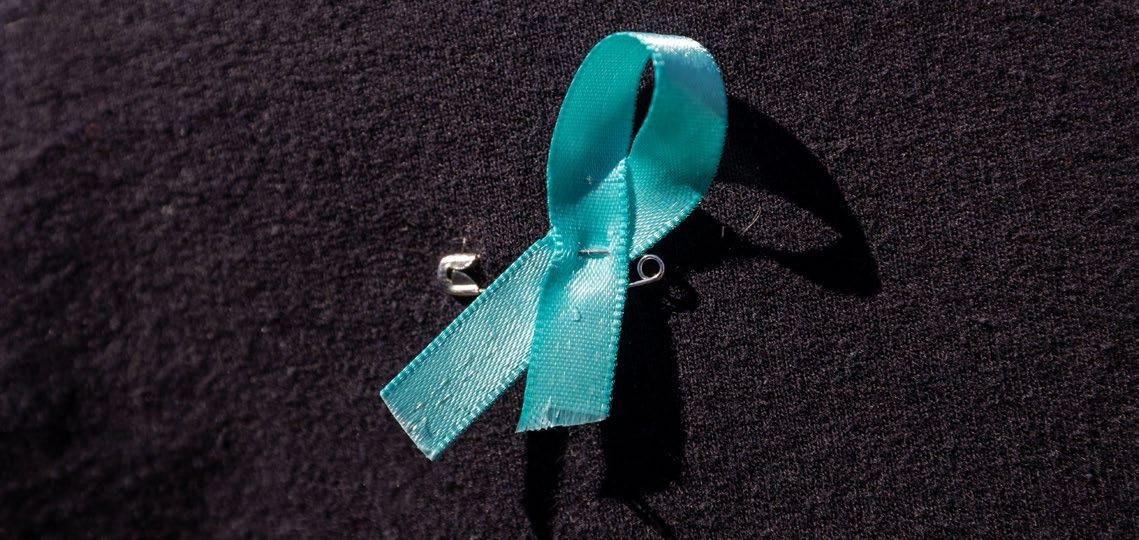
untold
Yasay and Woligroski also had similar concerns regarding a lack of education across the university.
“A lot of folks on campus still don’t know that the sexual violence policy exists,” said Woligroski.
Cable said she hopes the legislation will “pass without too much pushback,” and then formal work on those aspects can happen.
Cable said the government is “going to do everything we can to ensure that every student feels safe on campus.”
“I personally want every student to be able to attend post-secondary as their whole selves without fear.”
Yasay who sits on the university’s sexual violence steering committee said that while she has the opportunity to learn about sexual violence in many of her courses, and through her work with UMSU, she worries students may not be aware “how prevalent an issue it is.”
4 news@themanitoban.com Vol. 110, No. 29 News
photo / Matthew Merkel / staff
stories.”
photo / Matthew Merkel / staff
UMFM’s annual Pledge-O-Rama returns
Celebrate local broadcasting by donating from April 19 to 26
Sarah Cohen, staff
U MFM, U of M’s campus and community radio station, is bringing back its annual Pledge-O-Rama later this month after a four-year hiatus.
Pledge-O-Rama is the annual funding drive for UMFM, where listeners can donate to support the station.
Station manager Jared McKetiak said the radio station, on air since 1998, is a volunteer-run way for students to “express themselves either musically or through talk programming.” The station broadcasts all genres of music
and talk shows, and gives opportunities to local bands and podcasters.
Originally held in October, UMFM took a break from holding Pledge-O-Rama during the early years of the COVID19 pandemic. McKetiak said “it didn’t feel right to be asking members of the community for money when a lot of the folks in that community were struggling.”
The decision to bring Pledge-O-Rama back this year was because “this year, it felt like a real return to normalcy,” McKetiak said, noting the drive for students to get
involved on campus and the addition of over 30 new volunteers UMFM has trained this year.
2024 also marks the 25th year of UMFM being on air, something McKetiak said is important to celebrate, particularly in a time where access to media is being blocked by Meta and “we can’t really reach out to people through [the social media] channels that we’ve come to rely on.”
“It’s important to celebrate milestones like that for independent broadcasters and independent media
organizations,” he said.
“It was also a really good indication to us that it was time to celebrate what it is that got us here, and that’s being on the radio, and doing what we do on the regular.”
McKetiak said the fundraising goal for this year is $28,000, which is 15 per cent of the station’s operating budget. The goal of $28,000 is meant to help the station “rebuild and repair” from the hardship the pandemic left on the station.
Pledge-O-Rama will begin on April 19 at 6:30 p.m. and end one week later on April
Varma resigns as UMSU VPFO
26 at 8 p.m. Donations can be made online at any time at umfm.com/donate, over the phone by calling (204) 4746610 between 6 a.m. and 3 a.m. or in person at the UMFM office Monday to Friday from 10 a.m. to 5:30 p.m.
Those who donate are eligible for UMFM merchandise, a tax receipt or entry into one of the special bonus draws which give donors the chance to win tickets to music festivals and programming throughout the province.
Vice president finance and operations publicly resigns at UMSU board meeting
Colton McKillop, staff
UMSU vice president finance and operations Vaibhav Varma publicly resigned during a March 28 UMSU board meeting.
The board meeting featured presentations on motion 0604, a motion to adopt a definition of anti-Palestinian racism, although it is not confirmed whether the meeting’s events were a factor in Varma’s resignation.
Varma made his announcement to the board after a recess that was called in response to board of directors chairperson
Elbethel Masresha leaving the meeting. Masresha left following an exchange with Varma in which he accused her of having a conflict of interest in discussing the motion. He said she was “not fit to chair this delegation” based on social media posts he felt revealed her biases.
Varma said he would give the union one week’s notice before vacating the position.
Varma declined requests for an interview and has not made any public statements about the matter on social media since March 28. graphic / Dallin Chicoine / staff
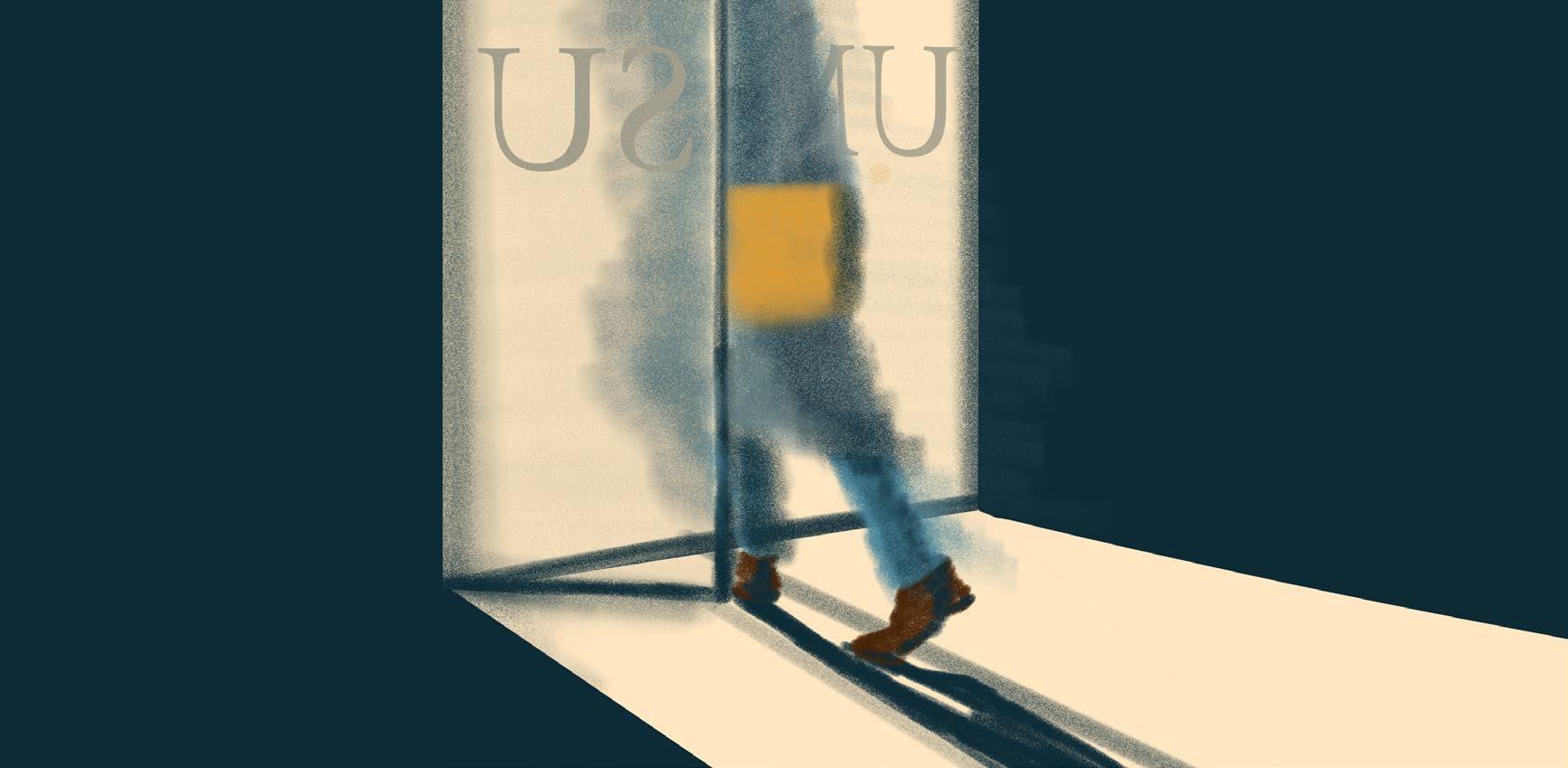
U of M pharmacy to close at end of April
Students can transfer prescriptions to their pharmacy of choice before end of month
Alicia Rose, staff
The pharmacy in UMSU University Centre will close at the end of this month. The closure of the pharmacy was announced in October.
Ahmed Hasan, a third year student at the University of Manitoba, said the pharmacy in University Centre was the primary pharmacy that they used, and it has been reliable resource for him since he lives on campus.
Hasan said having a pharmacy on campus is very important to him, since he spends most of his week on campus, so when he has to pick up prescriptions, he can easily access them.
“It works with my insurance constantly, I don’t have to figure out my group number, my certificate number,”
they said. “It’s built for the insurance that students have.”
Hasan said losing the pharmacy on campus will be “really sad” for them, as they will now have to figure out a new pharmacy to go to, review their insurance policy and notify their doctor.
“It’s too much of a hassle especially for someone who needs medication every month, like me,” he said.
Hasan was shocked when he learned that the pharmacy was going to close.
“When I was told that, honestly, it just felt sad and I couldn’t understand it,” they said.
“It just seemed not reasonable, because it’s a service that a lot of people use and its very useful.”
Andrea Edmunds, executive director of UM Ancillary Services, said in an email to the Manitoban that the pharmacy was established in 1974 with the goal of providing a student practicum opportunity for college of pharmacy students, but “more stringent rules and increased oversight” by the College of Pharmacists of Manitoba “have resulted in the current location and business model of the pharmacy no longer being sustainable.”
“Ancillary services is a strong advocate for supporting student success and we would not be moving forward in this manner unless it was necessary to do so,”
Edmunds said.
Edmunds said the pharmacy does “not have the volume, physical space or oper-
ating environment to support a traditional business model” hire additional pharmacists and comply with regulations.
Edmunds also pointed to reduced sales since the COVID-19 pandemic as a factor.
Hasan is a resident advisor for students living on campus, and they regularly refer students with prescriptions to the pharmacy on campus.
“If I was an RA for example next year again, I’m not going to be able to help a lot of these students because it will be more difficult, it will be more time consuming,” he said.
“Especially if they are moving from another country, it must be confusing because they need to learn an entirely new health system.”
Edmunds said many of the
pharmacy’s services will be made available at different locations on campus.
With the pharmacy closing, some over-the-counter medications will become available at GPA’s Campus Convenience. The UM Bookstore will carry retail items such as stamps, will serve as a pick up/drop-off location for Amazon and will offer some Canada Post services.
Those who use the campus pharmacy can transfer prescriptions to a pharmacy of their choice before the end of the month. After this deadline, remaining prescription files will be transferred to Greencrest Pharmacy at 1-2770 Pembina Highway.
5 news@themanitoban.com April 10, 2024 News
The interplay of mental health, the gut and cancer
Part of new research projects supported by UM Ignite Program
Elah Ajene, staff
Last month, the U of M launched its Ignite program to support bold and high-risk research explorations — providing $350,000 per year for three years to five collaborative research projects.
Among these is a multidisciplinary project led by Versha Banerji, an associate professor in the department of internal medicine.
The project, titled “An interdisciplinary approach to understanding how mental health, nutrition, multi-omics, and the microbiome interact in CLL to improve patient care” delves into the intricate interplay between mental health, gut health and cancer.
At the heart of Banerji’s research project lies a profound realization — the journey of cancer patients encompasses far more than just the diagnosis and treatment of the disease itself.
“We are now faced with supporting them through this journey in multiple different ways,” she said.
Recognizing the holistic nature of patient care, Banerji’s project aims to address the myriad factors that influence an individual’s well-being throughout their cancer journey. The project’s scope extends beyond traditional biomedical approaches, incorporating elements of nutrition, mental health and activity to create personalized treatment plans for each patient’s unique needs.
“The project specifically is to bring together a community of researchers that has not been brought together before,” Banerji said.
A key focus of the research involves exploring the connection between mental health and cancer progression through a multidisciplinary approach.
The team aims to gather real-time data on patients’ mental well-being in a naturalistic setting, free from the biases inherent in traditional clinical assessments. Banerji explained that this approach allows for a deeper understanding of patients’ psychological experiences, untethered from the context of medical appointments.

ology Renée El-Gabalawy, among others, is helping to develop questionnaires designed to capture the nuances of patients’ mental health journeys by adopting an approach that minimizes intrusion into their daily lives.
Another critical aspect of the project involves investigating the role of the gut microbiome in cancer progression and treatment response. This segment is led by Heather Armstrong, assistant professor in the department of inter-
ing momentum in potentially creating information that we could act upon early.”
Through comprehensive analysis of stool samples and blood plasma, the researchers aim to explain how the microbiome influences cancer progression and how it responds to treatment. By integrating data on the microbiome, immune system and tumour cells, they hope to identify markers that can predict patient progression risk levels and inform personalized treatment strategies.
“The number one motivator for me is improving the quality of care and the quality of their lives”
— Versha Banerji, U of M associate professor in the department of internal medicine
Researcher in the department of clinical health psych-
nal medicine. “The microbiome piece is something that is not often looked at in cancer,” Banerji said, “but [it] is gain-
One of the challenges Banerji foresees lies in integrating diverse datasets and methodologies to derive meaningful insights.
With a multidisciplinary team comprising experts in genetics, proteomics and health services research, Banerji is spearheading efforts
to bridge the gap between disparate fields and create a cohesive framework for data analysis.
“It’s an innovative way to potentially create prediction models of care, so that you can identify which patients are best suited for physician-led care or some that are suited for nurse-led care,” Banerji said.
Banerji highlighted the potential cost savings associated with early profiling of cancer patients, emphasizing that while the upfront testing costs may seem substantial, they have the potential to lead to significant savings in the long run. By appropriately directing resources based on early profiling, health-care systems can mitigate future expenses associated with complications.
Looking ahead, Banerji envisions a future where personalized medicine is not just a buzzword but a reality.
When asked about her inspiration for delving into this project, Banerji shared a
personal story that ignited her dedication. She recounted the impact of her grandmother’s battle with chronic lymphocytic leukemia. Witnessing firsthand the challenges of cancer and the onset of the COVID-19 pandemic underscored the importance of exploring holistic health-care approaches for Banerji.
For Banerji, personalized medicine entails more than targeting specific mutations. It involves harnessing a wealth of patient data to tailor care plans that optimize outcomes.
She hopes the project will lead to the development of predictive models that can guide clinical decision-making and optimize patient care.
“I have the advantage of being a physician and actually being intimately involved in my patients’ lives,” she said.
“The number-one motivator for me is improving the quality of care and the quality of their lives.”
Research & Technology 6 research@themanitoban.com Vol. 110, No. 29
graphic / Teegan Gillich / staff

NEED A BOOST? IQ’S HAS YOU COVERED! Starbucks Hot and Cold Beverages 3rd Floor University Centre UMSU JOB OPPORTUNITIES umsu.ca/jobs Full-Time Part-Time Summer Roles On behalf of UMSU, we wish you great success in your upcoming exams! May luck be in your favour and your preparation bring fantastic outcomes! www.UMSU.ca @myumsu
Breaking down liver disease
Assistant professor talks causes, treatments and the future of liver disease
rhea Bhalla, staff
One in four Canadians is possibly affected by liver disease. Often, those with liver disease are unaware of it until the disease reaches an advanced stage.
Robin da Silva is an assistant professor in the U of M’s Max Rady college of medicine. The da Silva lab researches the development of fibrosis, scarring of the liver, during liver disease.
The most common type of liver disease is non-alcoholic fatty liver disease (NAFLD), an accumulation of fat unrelated to alcohol use.
“That’s a very broad disease, where you have fat in the liver and some what we call elevated liver enzymes,” da Silva said. “A lot of people have that, and many people don’t know that they have that.”
NAFLD is often seen in patients with metabolic syndrome. Metabolic syndrome is a group of health conditions including high blood pressure and sugar, excess body fat carried at the waist and abnormal cholesterol levels. The syndrome affects up to one third of adults in the United States and increases the risk of heart disease, stroke, Type 2 diabetes and liver disease.
Though NAFLD may be mild and not present any symptoms, about 10 to 15 per cent of people with the condition will develop non-alcoholic steatohepatitis (NASH). Characterized by excess fat deposits and inflammation, NASH can cause liver damage similar to that experienced by alcoholics, even among those who do not drink.
Minor liver damage can be repaired by the body. However, the deterioration associated with NASH may be too severe. Fibrosis is a process that occurs when scar tissue replaces damaged liver tissue.
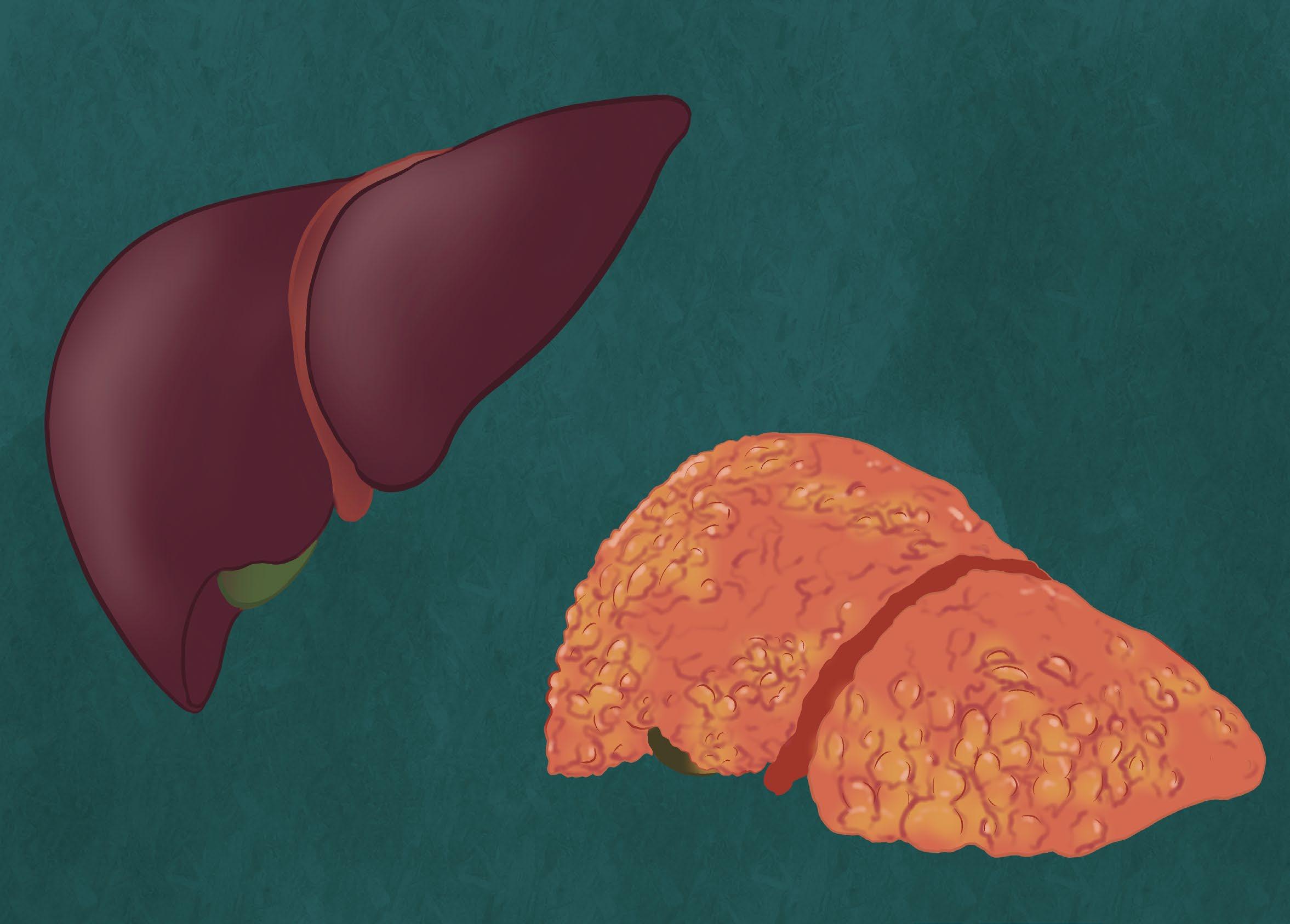
inflammation stimulates more immune activity,” da Silva said. “Those immune cells basically generate fibres in the liver. That’s a normal process that does happen normally whenever you’re turning over tissue, but the problem is when that becomes disordered, and it accumulates.”
Almost no therapies exist to treat fibrosis. In patients who are obese, losing body weight can help reduce the amount of fibrosis in their liver. Even then, da Silva said that this approach is often unsustain-
betes inhibit appetite, which may be beneficial in treating fibrosis as it causes weight loss. However, this has not been studied within the context of fibrosis.
“There’s some new things happening, but this is kind of skirting the issue,” he said. “It’s getting at it from the other end. It’s not dealing with what the source of the fibrosis is.”
“This is one that we have no treatment for, which is astonishing”
— Robin da Silva, U of M assistant professor in the Max Rady college of medicine
“When the immune system is trying to do its work, if there’s inflammation, this
able, as weight loss is difficult, and many people eventually return to their previous body weight.
Certain drugs used in dia-
Da Silva’s research focuses on how immune cells are generating fibrosis in the liver. The da Silva lab has found that folate and B12 metabolism influence the behaviour of these immune cells by reducing the severity of liver fibrosis. For many patients, the battle against liver disease does not end at fibrosis.
“[Patients may go] from NAFLD to NASH,” da Silva said. “And NASH is when you
have that inflammation and fibrosis, and when that fibrosis accumulates to a certain extent, it starts to prevent blood flow through the liver, and at that stage, we start to refer to it as cirrhosis.”
Cirrhosis, he explained, is a very serious condition for which there is no treatment. The only options for patients diagnosed with cirrhosis are tissue transplants or the removal of liver tissue. Those diagnosed with compensated cirrhosis typically have a life expectancy between two to 12 years.
According to the National Institute of Alcohol Abuse and Alcoholism, heavy drinking is consuming at least five drinks per day, on five or more days in a month. A 2019 study found that 20 to 25 per cent of people who drink heavily over a long period of time will develop cirrhosis.
Certain diseases, such as the viral diseases hepatitis A, B and C, may induce fibrosis. Hepatitis C is especially prone
to generating fibrosis.
“Newer drugs have been developed that are effective at treating hepatitis C,” da Silva said. “About 10 years ago, that was very difficult to do.”
“Vaccines do a lot for hepatitis,” he added. “We don’t realize it in the same way that we don’t realize how good the vaccines are against mumps, measles and rubella, and the other ones that we get vaccinated against, because we don’t see them anymore.”
Da Silva emphasized that rates of liver disease have continued to rise, noting that “this is a problem that’s becoming a bigger problem.”
“More research is needed for this,” he said. “The big message is, about fibrosis, that there’s no treatment for it. We have treatments for many diseases. We have fantastic medicines. But this is one that we have no treatment for, which is astonishing. And to get those medicines, to develop those medicines, we need more research.”

8 research@themanitoban.com Vol. 110, No. 29 Research & Technology
graphic / Teegan Gillich / staff


Who says we should defund the CBC?
Canada’s public broadcaster vital for access to information
Gillian Brown, staff
A sizeable portion of Canada’s right wing believes the CBC should be defunded. Perhaps the most vocal is the leader of the Conservative Party of Canada, Pierre Poilievre, who promises to defund the broadcasting corporation if elected prime minister.
In late February, instead of answering a Canadian Press reporter’s question, Poilievre accused them of working for a “tax-funded media outlet and spreading Trudeau’s message.” Was he confused, uninformed or deliberately spreading misinformation when he said that? His opinion on the CBC is well-known at this point, but the Canadian Press is not a publicly-funded national news outlet. It’s a news wire service owned privately and paid into by a number of Canadian daily newspapers. Compared with the CBC, the Canadian Press’ funding model and mandate don’t come close to what some critics of the broadcaster argue.
The statement may not have malicious intent behind it, but the fact that Canadians cannot rely on politicians to relay correct information to the public, and the fact that his statement was accepted as true by many, demonstrates how strongly we need reliable access to information. Poilievre does all Canadians a disservice by perpetuating narratives that any remotely-publicly-funded media is corrupt.
Aside from being inaccurate, the party leader’s promises and comments on the outlet are downright dangerous for a free and functioning Canadian democracy.
Poilievre’s position isn’t just backed by empty threats. The Conservative party’s website includes a petition supporters can sign that calls on the Liberals to defund the CBC. Part of its argument is that the CBC provides coverage and opinions that are available in a “free and competitive media marketplace.”
But Canada’s media environment can’t be classified as free and competitive, and it certainly shouldn’t be cultivated as a “media marketplace.”
There are some independent outlets in Canada, including Winnipeg’s own Free Press. But largely, news media in the country is owned by one of a few major companies. One is Postmedia, which owns roughly 130 titles and routinely shuts down its acquisitions, many

of which are local and community newspapers, leaving those communities without reliable access to information. Another is Bell Media, which owns multiple TV and radio stations. It recently laid off 4,800 employees, and plans to sell around half its radio stations and end its weekday noon newscasts on every CTV station except in Toronto. That doesn’t seem like much competition, and, given Postmedia’s history of endorsing Conservative candidates and discouraging editorial views that criticize Conservative leadership while the publication endorses the party’s leader, it doesn’t seem very free either.
The Conservative’s petition to defund the CBC relies on the premise that these opinions and coverage will be widely available elsewhere, but the media landscape is increasingly constricted by corporate ownership, and public opinion polls clearly show that corporations cannot rely on readers to fund these opinions and coverage. As demonstrated in a 2022 report by Statistics Canada, they certainly can’t rely on advertising dollars.
If Poilievre’s Conservatives and Canada’s media conglomerates want to treat access to information like a failing business, we need an organization that won’t.
A common misconception about the CBC — one parroted by Poilievre and past Conservative leaders — is that, being publicly-funded, it acts as a biased mouthpiece for Justin Trudeau and the Liberal party. CBC has existed since long
before Justin Trudeau. It existed during Harper’s tenure as prime minister, and Mulroney, and Diefenbaker, going as far back as Mackenzie King. Point 46(5) of Canada’s Broadcasting Act affirms CBC’s independence when it comes to freedom of expression and journalistic independence. So, while the broadcaster receives funding from the government, even the financial provisions of the act acknowledge and respect the outlet’s journalistic independence and integrity.
What Poillievre has said isn’t just misinformation, it’s an active effort to stifle one of the country’s most accessible sources of information.
Complaints that the CBC leans left are taken out of the Canadian media context. Situated in an environment where the majority of news media is owned by conservative corporations that prioritize profit over information, it certainly may seem like it leans left. The truth is, though, the CBC’s content is broad, and while it publishes a significant amount of political content during elections, its news reporting critical of government is limited, no matter which party holds office. There is no more bias than any other Canadian outlet when it comes to the CBC’s news reportage.
First, the distinction between opinion and fact must be distinguished. This confusion often comes from wilful ignorance, or a lack of media literacy. CBC has a responsibility to foster a variety of viewpoints, including those that Conservatives —
as well as Liberals — disagree with. That does not make the broadcaster biased. In general, publications do not automatically endorse the opinions they publish.
That distinction aside, there is no obligation for an op-ed to cover “both sides” of an argument. Publishing an opinion that doesn’t acknowledge arguments for and against an issue is a frequent occurrence in publications worldwide. That includes the CBC, but it also includes national Canadian newspapers like the National Post and the Globe and Mail
But even in news writing, objectivity in reporting is virtually impossible. There will always be a person — whether it be a reporter or an editor — making decisions about what to cover, what angle to take and who to interview. This remains true for outlets beyond the CBC. That does not mean that there is no responsibility, respect and care involved, and it certainly does not mean that there is inaccuracy or bias in reporting.
The CBC is not pro-Liberal, nor is it anti-Conservative. The Liberal party has held federal office more often than not throughout Canadian history. Historically, the Liberal party — just like the rest of the major Canadian federal political parties — has been, and continues to be, vastly centrist. The way news is reported doesn’t necessarily reflect an institutional bias, but rather, Canadian culture at large.
But accepting that the CBC, just like any other Cana-
dian publication, cannot be fully objective in its reporting, there are broader consequences to treating the country’s media sphere as a marketplace.
The term “marketplace” assumes Canada’s media outlets are primarily supposed to generate revenue, and that news must function as a product. Given the perpetuation of misinformation from the people vying to lead the nation, profit cannot be the main goal of those who fund our media outlets. If it is, editorial standards and mandates are more likely to appeal to advertisers, which can find themselves in conflict with journalistic standards and responsibility.
A Leger poll from this past September suggests that a majority of Canadians think news should be not only widely accessible to all, but free as well. This is a fantastic trend, but the problem is, only six per cent of the poll’s respondents would actually pay directly for a subscription to a news outlet.
Considering both the journalistic standards and autonomy of the CBC and Poilievre’s documented history of misinforming Canadians to suit particular narratives regarding the media, and considering the alternative being corporations treating what is supposed to be information like a product that advertisers can buy, it is entirely possible that, maybe, Conservative talking points just don’t line up with the facts. That’s no reason to defund Canada’s most accessible and long-standing broadcaster.
Editorial 10 editor@themanitoban.com Vol. 110, No. 29
graphic / Dallin Chicoine / staff
On campus news, Karuhogo’s UMSU and Palestine
Dispatches from a tumultuous year at the ’Toban
Jessie Krahn staff
What, exactly, is the point of a student newspaper?
I joined the Manitoban as an arts & culture reporter in the fall of 2022 to build my portfolio and make friends in the final hours of my mostly-remote graduate degree.
Since then, I began editing the paper’s comment section and, over time, I took on various degrees of editing in every section of the paper — all the way from news to diversions.
My opinion of local newspapers has radically evolved — as it often does for so many of the ’Toban’s alums. I thought of the paper as little more than a low-stakes training ground for future journalists, writers and researchers.
But watching the community reel, rally and react — especially to Israel’s near-ceaseless bombardment of Gaza — through the Manitoban’s pages, I realized local news is indispensable.
What’s difficult for people around the world is that what happens in Palestine, however far away the place might seem to be, has material and direct impacts on so many lives much more acutely than many other geopolitical issues. I witnessed this first-hand, as the Manitoban became “crucial” for “careful and engaged conversation” as Adele Perry and Pauline Tennent wrote for the Centre for Human Rights Research. The landslide of articles I was charged with editing demonstrated to me just how crucial the paper was. We published almost four dozen guest opinion pieces this publishing year alone. While they weren’t all about Palestine, each article was written by a unique individual who was equal parts fearful and hopeful for bringing their writing to the public.
The ’Toban was an outlet for U of M faculty, alumni and students, U of W faculty and staff, Winnipeggers in general and even readers from around the continent, to virtually congregate and dialogue.
Editing at a campus paper while Israel tightened its stranglehold on Palestine invited a level of stress into my life I had never experienced before. Dozens of little fires ignited weekly, and I had to put them out while providing an evenhanded platform to reflect the views of a community stretching far beyond
the borders of the U of M campus. Palestine specifically and the paper generally have had profound impacts on the community, especially in lieu of student government execs with a spine.
Tracy Karuhogo’s UMSU has been chronically silent on the havoc Israel continues to wreak on Palestinians and the ways the genocide constantly spills into local contexts, as I’ve written about almost ad-nauseam. Her executive team, including incoming president Divya Sharma, Liam Pittman, former exec Vaibhav Varma and Christine Yasay cemented their government’s legacy by their habitual cowering in corners until they were called away for photoops.
humble little island for highlighting the issues. UMSU ruled Arij Al Khafagi’s motion to acknowledge and affirm students’ rights to free expression out of order. Al Khafagi’s suspension for comparing the Israel Defence Forces to Nazis was intertwined with the public’s conversation about it, particularly in the Manitoban, and UMSU failed to participate in it.
M community, forcing contradictions roiling just beneath the surface of our institutions’ outer coatings to the surface.
ant to deal with, and pulling the data would take four more weeks.
Apparently being transparent with the press is too low-priority for anyone in UMSU to worry about.
Some might argue that it’s not the student union’s place to comment on geopolitics, despite their history of calling for a de-escalation of tensions in the Middle East in response to the threat of nuclear war in Iran.
But even on explicitly local matters where institutions’ stances on Palestine led to them taking a stance against individuals, the ’Toban remained a
Al Khafagi’s suspension wasn’t an isolated incident. U of M student and Diversity4Palestine vice president Hussein Shoker posted a video to Instagram of a person assaulting him while he chanted at a rally for Palestine. This, alongside HonestReporting Canada’s routine of accosting absolutely anyone writing for the Manitoban in support of Palestine, testify to the ways this genocide has touched and will continue to touch the U of
Considering Karuhogo’s administration’s cowardly, deafening silence on both Palestine and the incidents where people faced ramifications for just speaking about it, where else could the U of M community — and the Winnipeg community writ large — find representation for their views?
It is the one place in our community where we can forge the connections between the local and the global when local governments fail to advocate for us
I was aware that part of the paper’s purpose was to place checks on student government and hold them to account. In the face of Karuhogo’s administration’s aggressively juvenile opaqueness, I’ve only come to feel the importance of that function more urgently.
The Manitoban has been requesting information from UMSU on voter turnout to UMSU elections for close to four weeks. UMSU’s designated PR goon and governance administrative co-ordinator responded just last week, saying that other things were more import-
In an embarrassingly sophomoric skit posted to UMSU’s Instagram, Yasay walks into a room to find a snoozing Karuhogo and asks, aghast, “Tracy, what are you doing?” Yasay reminds her shortly after that they’re late for a party.
Here’s the sickening irony, that Karuhogo and her executive team remained shuteyed in the wake of anything from mass death abroad to encroachments on students’ freedom of speech at home, prioritizing party attendance, doing nothing and even sleeping, over doing something substantial with their time in student government. Like a narcoleptic semi-truck driver careening toward the end of her tenure — indeed, Tracy, what are you doing?

There is a need for a local venue to ask this question, to highlight the problems with student government.
Local news is critical for sustaining a healthy democracy. As civic journalism becomes more impoverished, there are dire consequences for all levels of society. And, considering that very few national outlets would take interest in reporting on sleepy union presidents or evasive local leadership, this shouldn’t come as a surprise to anyone.
The Manitoban is the one of a few disappearing places where these criticisms can be voiced. It, like so many other local newspapers, is the one place in our community where we can forge the connections between the local and the global when local governments fail to advocate for us. The one question that bears repeating is — where else could these stories be told? What I’ve learned over the years, from conducting interviews to working with writers on their pieces, is that the Manitoban plays residence to stories that might otherwise never have been recorded.
A part of being a human is being part of the local. This is the first place where we get acquainted with the world around us. What’s local matters. What’s local is worthy to remember. The Manitoban matters because it is meant to serve the local, to maintain that link between the people and world.
11 comment@themanitoban.com April 10, 2024 Comment
graphic / Teegan Gillich / staff
Student journalism is the need of the hour
Friendship, community and future at the Manitoban
l akshmisree Shaji, staff
I grew up interacting with print journalism, but I also witnessed the booming popularity digital media received in a matter of a few years. Many have wondered whether digital journalism will turn print into an obsolete form of news consumption. Since the start of the global pandemic, print journalism has taken an even larger backseat to its digital counterpart than it had previously, but I hope both print and digital forms of journalism will coexist despite the seemingly popular acceptance of the latter.
Publicly funded papers like the Manitoban offer news to their readers without a paywall. Readers can pick up a free copy of the print edition or read the paper online any time.
Unlike other sources of information for our university students like UM Today or UMSU’s news content on its website, the Manitoban, as an independent publication, holds institutions accountable and gives voice to the students’ needs and concerns.
The balance between print journalism and digital information is most important for student journalism. Our readers might pick up the week’s issue from one of the stands on campus, but when classes were online, international students like me relied on the digital issue for news. The Manitoban’s updates on the 2021 faculty strike made important information available and
accessible to all.
Journalism as a discipline is important, but student journalism plays a significant role on campus by building community and making information accessible to students. By being part of the ’Toban team, I have not only honed my writing skills but also found kinship with my fellow team members.
That opportunity is available to everyone in the university. Even if you do not want to work at the ’Toban, you can submit volunteer pieces and contribute to the conversations around you.
And that is important, because in a day and age where information sharing is constantly tampered with by many external sources, getting a platform to raise your voice becomes a necessity.
The use of artificial intelligence (AI) in photos, videos and news has been the topic of discussion for quite some time now. The discourse on the AI issue with Kate, Princess of Wales, and Meta’s news ban in Canada are two of the recent examples of the threat of disinformation spreading.
There have also been instances in the Manitoban’s history when the paper’s truth-seeking abilities have been threatened.
In 2018, Commerce Students’ Association representative Cole Parsons introduced a motion to hold a referendum on defunding the Manitoban. The students, faculty and other readers of the newspaper acted promptly.
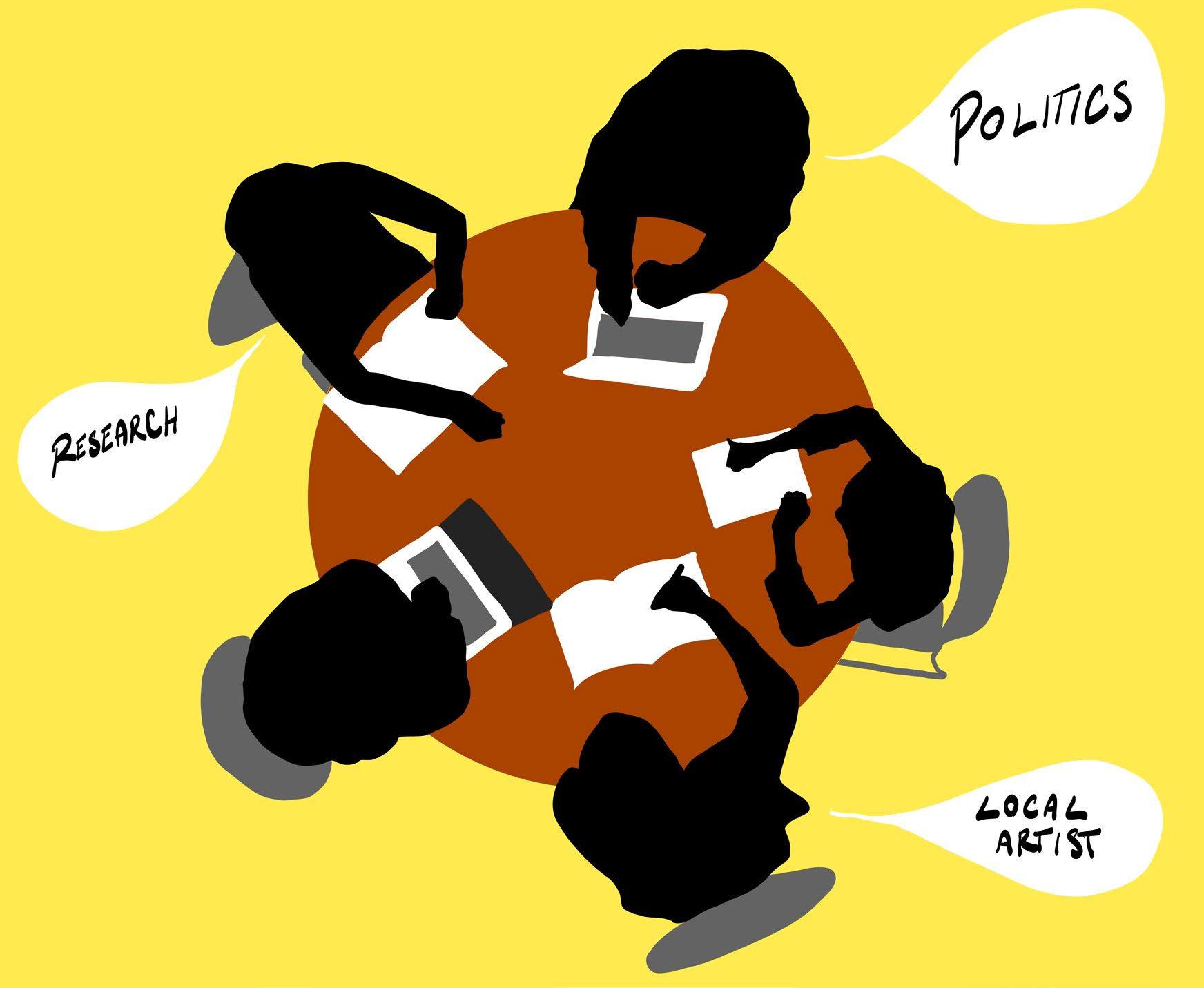
They came forward to defend the paper, and the motion was withdrawn.
Student journalism can be potentially threatened by people in power who do not take into account the value of community and the paper’s role in holding institutions to account.
In the last academic year, we have reported news on matters important at provincial, national and international levels. The research & technology, arts & culture and sports sections have reported on matters that pertain to the
students, faculty members and other readers. I worked as a columnist at the Manitoban in its 110th publishing year, and the section has published opinion pieces on topics ranging from public transportation and education to gender equality and capitalism.
As we witness the humanitarian crisis in Palestine, human rights violations in the Democratic Republic of Congo and the rise of far-right leadership around the world, it has become all the more important for us to keep our ears to the ground and amplify the
voices of those in need.
This is my last column as a columnist at the Manitoban I’m honoured to have been a part of the paper, and this experience has taught me a lot. I value the relationships I developed by working at the Manitoban, and I’m thankful to my team members who offered me guidance, support and, most importantly, friendship.
UMSU continues anti-Palestinian racism definition talks
U of M prof speaks to need for unity
To the editor, I was sad to see, in the article “UMSU continues anti-Palestinian racism definition talks” (April 3), reference to “both” and “each” communities. Presumably this meant the Jewish student community on the one hand, and the Palestinian (or perhaps Arab or Muslim) student community on the other. This paints a simplistic and unnecessarily conflictual picture. I know
for certain that among Jewish students there are a variety of perspectives, and real disagreements, on the issues at stake. My course RLGN 3400, Zionism: Religious Perspectives, to be offered this fall, will explore some relevant lines of thought within different streams of religious Judaism.
I also know that my Palestinian and Jewish students have much more in com-
mon than anything that divides them. The conflict in the Middle East is in the Middle East, and we should not assume that it is also a conflict between communities here in Winnipeg. It does not need to be.
Sincerely,
Justin Jaron Lewis Associate professorJudaism Department of religion

12 comment@themanitoban.com Vol. 110, No. 29 Comment
/ Dallin Chicoine
graphic / Dallin Chicoine /
letters@themanitoban.com Vol. 110, No. 29 Letters
graphic
/ staff
staff
To complete Sudoku, fill the board by entering numbers 1 to 9 such that each row, column, and 3x3 box contains every number uniquely. In Straights, like Sudoku, no single number 1 to 9 can repeat in any row or column. But rows and columns are divided by black squares into compartments. Each compartment must form a “straight.” A straight is a set of numbers with no gaps but it can be in any order, eg [7,6,9,8]. Clues in black cells remove that number as an option in that row and column, and are not part of any straight. Glance at the solution to see how “straights” are formed.



13 graphics@themanitoban.com April 10, 2024
Diversions
Straights Puzzle by Syndicated Puzzles Puzzle by Syndicated Puzzles Vol. 110, No.29 graphics@themanitoban.com Sudoku Sudoku Solution Straights Solution
xkcd.com xkcd.com 2024 Alance AB Provided by: Teegan Gillich 54 7 © 2024 Syndicated Puzzles 827 8367 732 13 8524 21 836 5984 967 © 2024 Syndicated Puzzles 851263947 972845613 634719825 429631758 385497261 167582394 713956482 298174536 546328179 Tough 237645 346521 89745612 3456798 456897 4321798 89576432 983265 672143 9 7 3 1 2 6 8 How to beat Str8ts Like Sudoku, no single number can repeat in any row or column. But... rows and columns are divided by black squares into compartments. These need to be filled in with numbers that complete a ‘straight’. A straight is a set of numbers with no gaps but can be in any order, eg [4,2,3,5]. Clues in black cells remove that number as an option in that row and column, and are not part of any straight. Glance at the solution to see how ‘straights’ are formed. Previous solution - Medium SUDOKU To complete Sudoku, fill the board by entering numbers 1 to 9 such that each row, column and 3x3 box contains every number uniquely. For many strategies, hints and tips, visit www.sudokuwiki.org If you like Str8ts check out our books, iPhone/iPad Apps and much more on our store. The solutions will be published here in the next issue. www.str8ts.com No. 2070 Medium Previous solution - Very Hard 7 21 8 5 9 © 2024 Syndicated Puzzles 851263947 972845613 634719825 429631758 385497261 167582394 713956482 298174536 546328179 To complete Sudoku, fill the board by entering numbers 1 to 9 such that each row, column and 3x3 box contains every number uniquely. For many strategies, hints and tips, visit www.sudokuwiki.org If you like Str8ts check out our books, iPhone/iPad Apps and much more on our store. issue. Medium Previous solution - Very Hard 2 2 8 6 97 7 728 37 9 7 3 1 2 6 8 © 2024 Syndicated Puzzles 83 9256 312 67 54972 72 158 81 3 STR8TS No. 2069 Medium 98423 765324 58376412 678423 4569783 324895 21536784 324167 13256 6 5 1 7 9 4 How to beat Str8ts –Like Sudoku, no single number can repeat in any row or column. But... rows and columns are divided by black squares into compartments. These need to be filled in with numbers that complete a ‘straight’. A straight is a set of numbers with no gaps but can be in any order, eg [4,2,3,5]. Clues in black cells remove that number as an option in that row and column, and are not part of any straight. Glance at the solution to see how ‘straights’ are formed. Previous solution - Easy SUDOKU The solutions will be published here in the You can find more help, tips and hints at www.str8ts.com No. 2069 83 9256 312 67 54972 72 158 8156 39 © 2024 Syndicated Puzzles 794213658 526748139 813956724 941532876 258671943 367894215 185329467 672485391 439167582 can But... by black These that is a set can be in black option not part solution to SUDOKU To complete Sudoku, fill the board by entering numbers 1 to 9 such that each row, column and 3x3 box contains every number uniquely. For many strategies, hints and tips, visit www.sudokuwiki.org If you like Str8ts check out our books, iPhone/iPad Apps and much more on our store. The solutions will be published here in the next issue. No. 2069 Very Hard Previous solution - Tough 15 by 45 orthogonal maze Copyright © 2024 Alance AB, https://www.mazegenerator.net/
Diversions
REIA hosts year-end hurrah
Empowerment gala recognizes racialized students, celebrates cultures and diversity
Kelsey Chin, staff
The Racial Equity and Inclusion Alliance (REIA), a student-led community group at the U of M which started operations in the fall of 2023, hosted their first Empowerment Gala to recognize and celebrate the diverse cultures at the U of M on Sunday, March 31.
The gala awarded racialized students and staff based on various accomplishments, such as athletic excellence and sportsmanship, academic excellence, achievement in visual and/or performing arts, accomplishment in impactdriven advocacy and effective representation and achievements bettering the racialized community on campus by a first or second year student.
Dinner and desserts were provided for attendees. The desserts, which were served buffet-style, were provided by various racialized businesses around Winnipeg and included things like alfajores by Munch It Pastry Shop and mini-Japanese-style cheese-
cakes by Rika Cheese Garden.
Throughout the evening, several cultural groups such as BIBAK Association of Manitoba, a group dedicated to preserving and promoting BIBAK culture and Dynamite Dance Crew, a dance troupe that highlights Afro-Caribbean style dancing, also took to the dance floor to perform.
While REIA has hosted numerous community assemblies with different cultural groups to learn more about them and their goals for the year, like lunch and learn events with different community groups and initiatives to raise funds for a racialized student scholarship, the gala presented an opportunity for racialized students to celebrate diversity, according to Dina Hamid, REIA co-events coordinator.
“I think it just allowed us to really embrace our culture, which sometimes we aren’t able to do going to a Western school in Canada,” Hamid told the Manitoban Attendees of the night were
encouraged to wear their cultural clothing to the event, an encouragement that many took kindly to — such as Hamid herself, who wore her traditional attire, a thobe.
“I don’t think I’ve ever attended a gala like that and I’m really honoured to be able to organize it with Dina and it was definitely a successful event,” said Allisther De Castro, founder and co-president of REIA and current UMSU racialized student representative.
“We’ve been planning, or thinking, about having our own racialized gala since the very beginning of the school year and I’m really glad that we made it happen and I’m just so happy that I saw a lot of students representing where they came from.”
De Castro also said that she’s received a lot of comments from people expressing how happy they were that they were able to “showcase their culture at an academic institution.”
Beyond celebrating the dif-
photo / provided

ferent cultures at the U of M, De Castro said she really wanted to ensure as many people as possible could attend the event without money being a barrier, which is why the empowerment gala was completely free for students to attend.
“I’m just really grateful for everyone who supported an alliance that I started,” said De Castro.
“We’ve had so many students support us along the way, go to our events, and I’m really glad to see them at our big final event.”
Basement Mixtape for Bisons — goodbye, hello
Saying goodbye to school and hello to summer
Jacob Davis, staff
Somehow, despite the unrelenting snowfalls in the last few weeks, we’ve made it to what appears to be springtime. As we enter exam season and finish our classes, anticipation for that sweet escape of summer is on everyone’s minds, I think.
It felt like a year of taking hits, bad news after bad news, but I was comforted by the indomitable human spirit and solidarity of fellow students. Despite crawling through the mud of studying, passing grades, busy schedules filled with classes and work on the side, I saw students come to each other’s aid, rallying for one another and keeping each other accountable.
Summer won’t be a cure-all, the world will keep turning and we will all find ourselves in different kinds of struggles, but even I can’t deny the urge to fantasize about the heat of the sun and the smell of flourishing greenery and how it feels like if you can make it there, you’ll be just fine.
Whether you’re graduating, returning to UC this fall or even on academic probation,
I’m rooting for you.
So, here is my farewell as your local mixtape maker — a playlist that, to me, sounds like summer, a little melancholic but welcoming in that heat and deadline-free future.
These tracks were picked in a combination of biased choices, groove-ability and what’ll be on repeat for me when that above-30-degrees heatwave that will have me immediately fed up with summer comes.
I included some honorary Hozier and Orville Peck tracks due to both of them coming to Winnipeg this summer — Orville Peck performing at Folk Fest in July and Hozier coming into town in August.
It’s going be a summer for yearning cowboys and exhausted academics alike and I hope this playlist sticks with you through it.
So long Bisons, happy trails.
Where’d All the Time Go?
— Dr. Dog, Shame, Shame
Ribs — Lorde, Pure Heroine
Cavalry — Mashrou’ Leila,
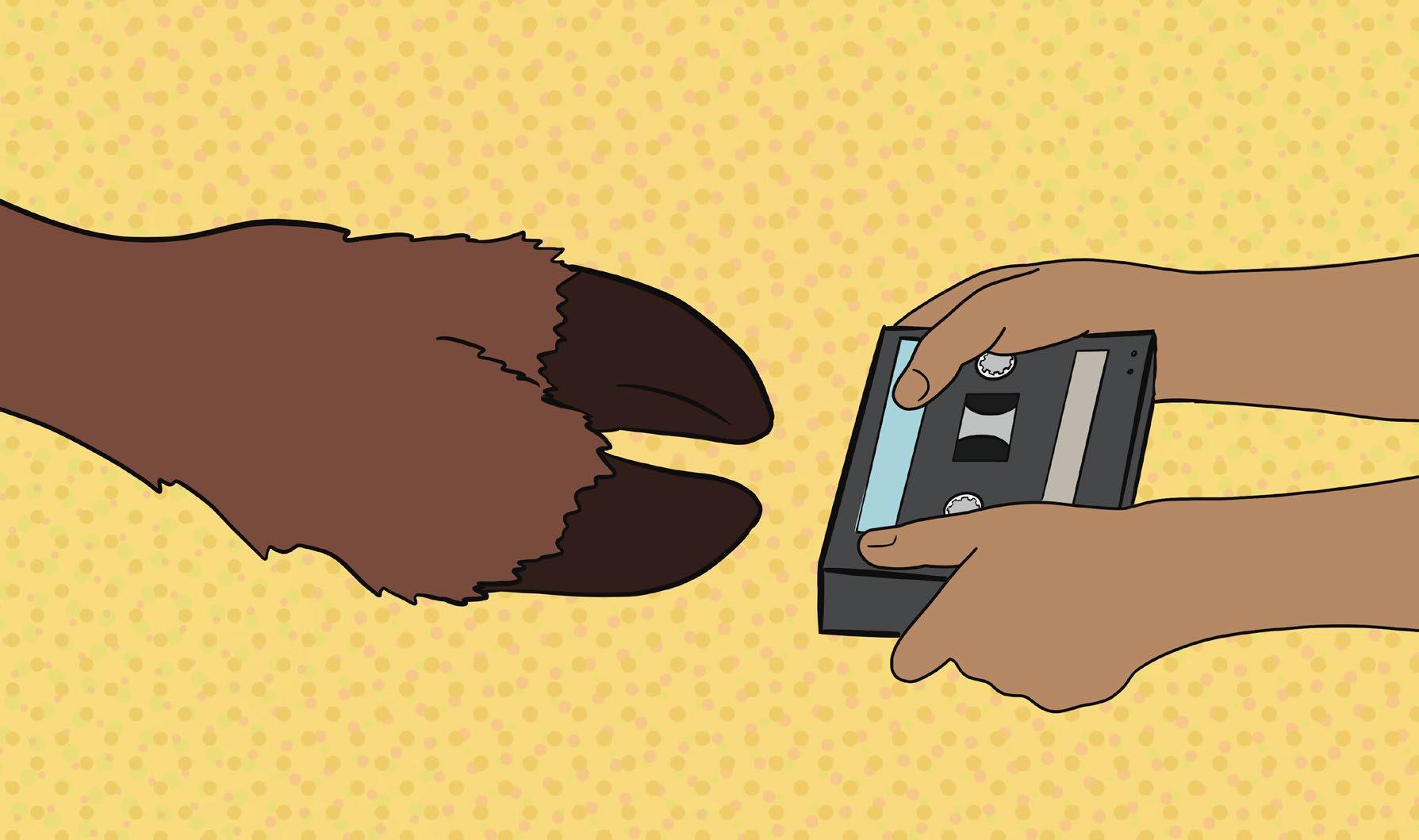
The Beirut School
Genesis — Grimes, Visions
GONE, GONE/THANK YOU — Tyler, The Creator, IGOR
Electric Feel — MGMT, Oracular Spectacular
Gospel For a New Century
— Yves Tumor, Heaven To A Tortured Mind
Harmony Hall — Vampire Weekend, Father of the Bride
Heat Above— Greta Van Fleet, The Battle at Garden’s Gate
Daytona Sand — Orville Peck, Bronco
graphic / Teegan Gillich / staff
KD and Lunch Meat — Boy
Golden, Church of Better Daze
Too Sweet — Hozier, Unreal Unearth: Unheard
Closing Time — Semisonic, Feeling Strangely Fine
&
14 arts@themanitoban.com Vol. 110, No. 29
Arts
Culture
A pinhole to the past Long exposure photography exhibit showcases student work
Alison Holliday, staff
Vanessa Warne, associate professor in the department of English, theatre and film and co-organizer of the Crafting Communities project, taught her ENGL 2140 Literature of the Victorian Period students how to take apart soda cans and turn them into pinhole cameras with tape and sewing pins and film back in the fall of 2023.
Installed throughout various locations across Manitoba, the cameras sat capturing long exposure images of light until they were taken down and developed in Warne’s office by the students themselves. On April 5 these images were put on display as a pop-up exhibition in the Haney Reading Room in Fletcher Argue.
Each of the photographs in the exhibit is haunting, with the pinholes capturing the light over many months, multiple photographs feature branches or long streaks of the sun arching across the sky from rise to set.
The overbearing presentness of sky and land in the images emphasizes the way the objects can become overlooked, with a plaque beside Glaiza Balanquit’s own piece describing the process as one that “reminded [her] that the sun is still a star.”
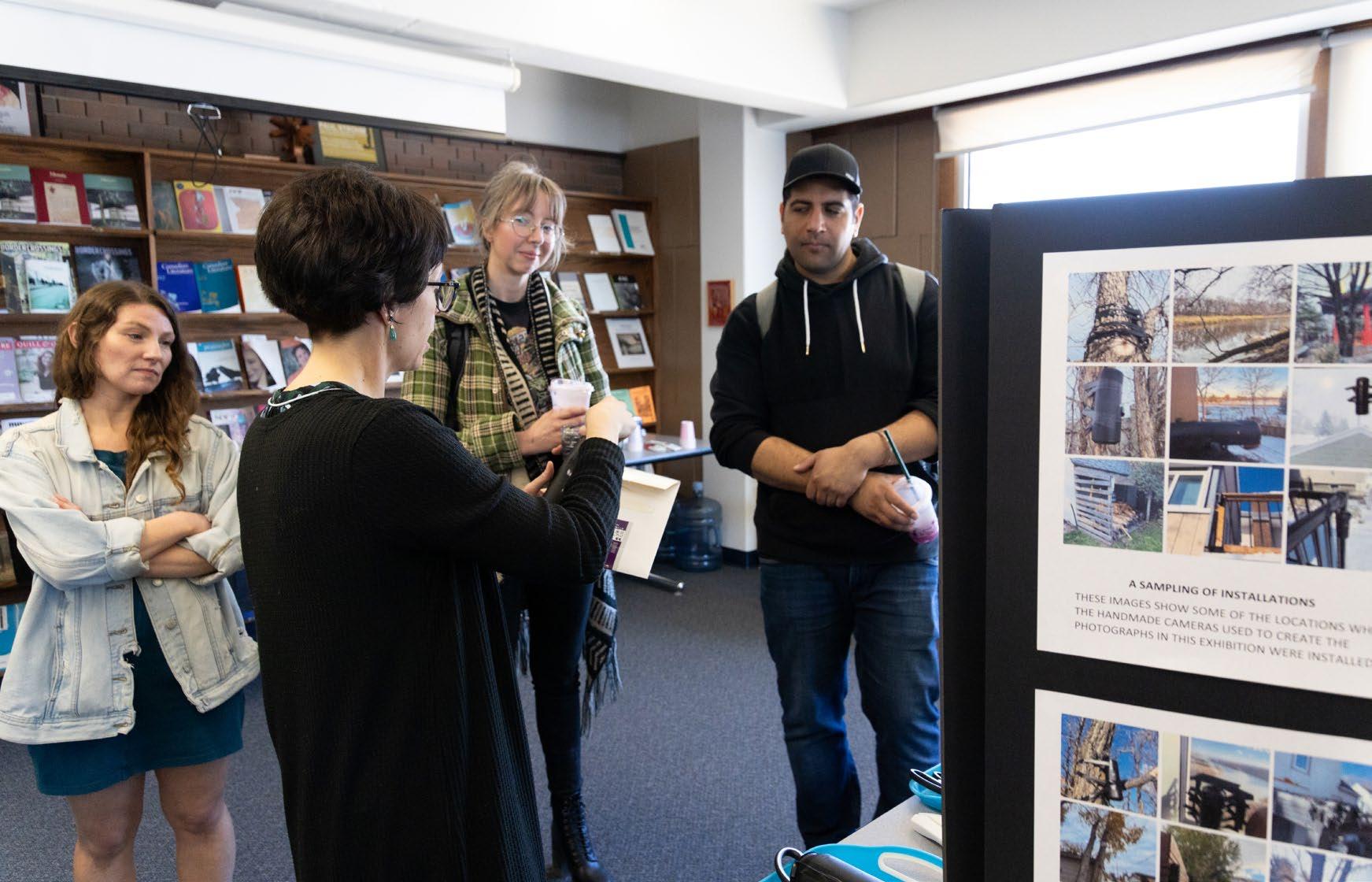
“I didn’t expect to be doing this in an English course,” Hannah Cole, music student currently enrolled in Warne’s class, told the Manitoban.
“Other English courses are not doing crafts, going on a field trip to Dalnavert Museum,” Cole said, adding that the joy in an eccentric class like Warne’s gives students a break from traditional
styles of academia while still learning about the Victorian era through this unconven-
“In this exhibition with everyone else’s images I feel a sense of connection and even a sense of pride”
— Hannah Cole, Student
tional course structure.
After Cole made her pinhole camera, she set it up in her backyard to capture an image of her house and other details
of her everyday life. However, when the film was developed, Cole’s image “just had some speckles and some strange marks.”
Warne and Cole theorized that the film slipped out of place inside the camera.
This “surprise failure” was used to refine the creative process. The next time Cole set up her camera the film was taped inside in the right placement.
Cole wasn’t the only student whose original project didn’t provide the expected results, unsurprising considering the images had to be left for so long to process. One student’s camera was even pecked at by an animal — “presumably a woodpecker” — achieving an unusual bleed of light onto the film during this time.
Cole found the process to be one that made her appreciate the everyday life of her backyard.
“Seeing it in this exhibition with everyone else’s images, I feel a connection, and maybe even a sense of pride,” she said.
Regarding learning about the Victorian era with this unique project, Cole said that this experience had her thinking about how photography has changed from that era in contrast to now and how accessible it is to take something as simple as a photograph with modern-day technology, something that wasn’t possible back then.
Readers can keep up with Crafting Communities for other Victorian Craft exhibits and opportunities at https:// www.craftingcommunities. net/ or @crafty_victorians on Instagram.

15 arts@themanitoban.com April 10, 2024 Arts & Culture
photo / Ebunoluwa Akinbo / staff
Bison women dominated U of M athletics
The many memorable moments of U of M women athletes
Quinn Mayhew, staff
Throughout the year, the U of M athletes have produced numerous monumental sporting highlights.
Although there have been many memorable moments this year, this article will call attention to women’s athletics, focusing on their achievements across Bison sports.
Football
Although one may assume football is a sport dominated by men, Maya Turner made a name for herself in 2022, breaking down those barriers to become the first woman to score in a U Sports football game. Turner kicked a 25-yard field goal against the University of Saskatchewan Huskies in the Bisons’ pre-season in August of that year, ultimately making history for Bison athletics while carving a new path for women in sports.
Turner made history in November 2023 as well, becoming the first woman to score points in a post-season game.
Turner continues to make waves as she kicks her way into the hearts of Bison fans.
Hockey
The women’s hockey team performed well throughout the season.
The team finished sixth in the CanWest standings and made the playoffs.
Emily Shippam, the U of M’s goalie, had a great year. She was named the CanWest hockey athlete of the week back in January, earning the distinction after saving 72 shots over the span of two games.
Overall, she finished the season with five wins and two shutouts.
As new recruits make their way to the team for the 20242025 season, the women’s hockey team will hope to build on its momentum from last season as Shippam backstops it all.
Swimming
The University of Manitoba made a splash this year, as athletes Ella Howe and Kesley Fillion had an amazing year.
Howe and Fillion both qualified for the Olympic trials and both got gold medals in CanWest competition.
Both individually and collectively, the women’s team had a great season.
In an interview with the Manitoban, Georgia Pengilly, a member of the team, offered some advice for young women entering university athletics, which should resonate with all women who are struggling to find footing in a male-dominated industry.
“Don’t be afraid to ask for what you want, and don’t be afraid to put yourself out there,” she said. “Be proud of yourself.”
As Pengilly’s time with Bison Athletics comes to an end, she reflects on her time with the swim team and the opportunities the U of M has provided her.
Pengilly told the Manitoban that she “learned so much,” while taking the time to express how “very grateful for swimming and Bison sports” she is.
Volleyball
The U of M women’s volleyball team absolutely dominated this year, winning the gold medal at the CanWest championship.
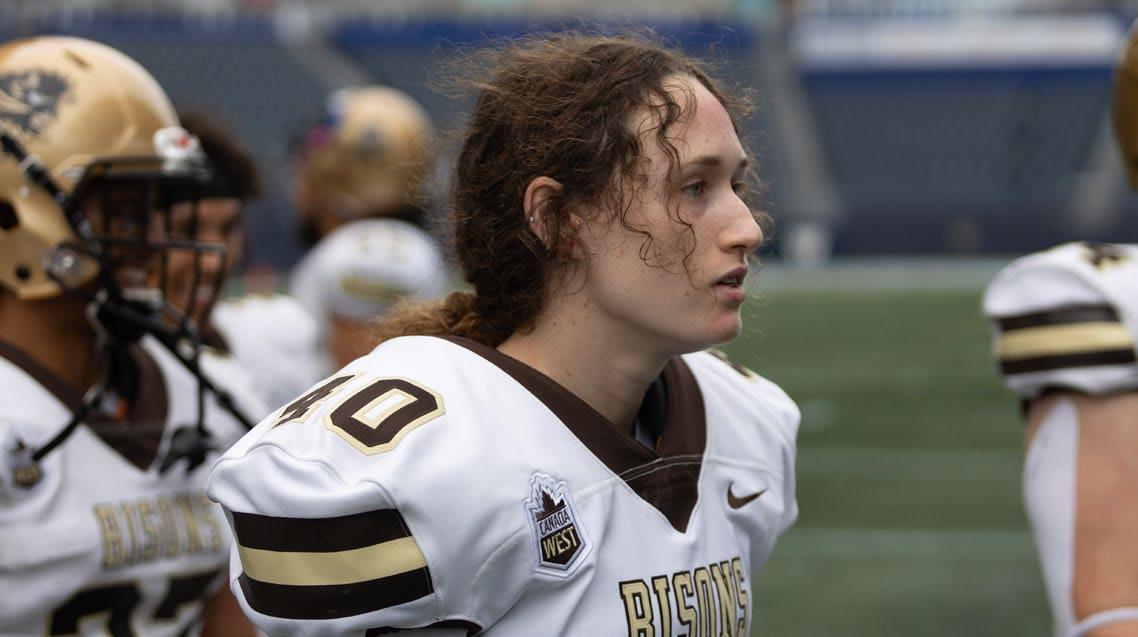
The U of M continued to crush the competition, advancing to the U Sports Championship in which it placed third.
Raya Surinx, one of the best university volleyball players in Canada, led the way for the herd, notching the most kills in the country with 388.
Surinx speculates that her and her teammates’ success has significantly increased interest in women’s volleyball. She noted to the Manitoban that going to the U of M, which tries to foster equality across mens’ and womens’ sports, has made a big difference, too: “in high school, it was not good, but getting to the U of M, it was such a big change.”
Josh on the Jets: at season’s end
“Suddenly,” she went on to say, “we were respected, we were promoted, people cared, people came to games.”
With women’s athletics getting the recognition it deserves, Surinx encouraged future and current Bison women athletes to keep going “If you love it, stick with it,” she said, ”No matter what skill level you are at, you always have a chance. If you love it, just keep going with it.”
Indeed, Surinx’s encouragement to girls can equally go out to women of all levels and ages in all sports — no matter one’s skill level, one should always have a chance to play and the opportunities to keep playing.
What needs to happen for the Jets to make a deep run, predictions and more
Joshua Brandt, staff
When looking up the Jets’ schedule online, occasionally, I inadvertently plunk in “Winnipeg Jest.” In years past, I would smile with cynical amusement and think to myself, “How fitting — this team is a jest.”
Moreover, in what proves that I spend too much time either watching or musing about the team, the first time I really paid attention to the lyrics of the song “Pale Blue Eyes” by the Velvet Underground, I thought, “Wow! This sounds like my relationship with the Jets!”
As the song goes, “Sometimes I feel so happy, sometimes I feel so sad, sometimes I feel so happy, but mostly, you just make me mad.”
Mostly you just make me mad, indeed. And yet, not this year. From a team whose only point of consistency used to be its inconsistency, the Jets are now performing well above expectations, having clinched a playoff spot weeks before the Stanley Cup playoffs begin on April 20.
This success goes against
the thoughts of most NHL pundits, who projected the Jets would miss the playoffs. However, the team looks formidable, boasting four lines of scoring and the best goalie in the league. It also loaded up at the deadline and is, at the moment, blessed with good health.
The memory of the 2018 run to the conference finals is etched indelibly in the minds of Winnipeg’s faithful. But it may soon be usurped.
On the playoffs
Likely, the Jets’ first-round opponent will either be the Dallas Stars or the Colorado Avalanche, either at home or on the road. Much remains undetermined. Nonetheless, should the Jets reach the conference finals, they would have to go through at least one of these two central division foes — even if Winnipeg finishes first in the division. Both seem daunting. Colorado has immeasurable firepower and a proven track record while the Stars’ team is fundamentally sound and
robust. Moreover, both are leading favourites to win the cup from the Western Conference.
All in all, either matchup would elicit extremely entertaining hockey, which is all one could hope for. Well, maybe one could hope that the Vegas Golden Knights are eliminated early, too.
To go deep, the Jets will need excellent goaltending, excellent defensive structure, discipline, timely goals from all over the lineup, and most importantly, they need to win the war of attrition.
Ironically, health is often an integral factor in reaching later rounds. Hopefully, the Jets will have it. If they do, I believe the team can fly to new heights.
Award predictions
Hart Memorial Trophy — awarded “to the player adjudged to be the most valuable to his team.” It must be Nathan MacKinnon. It’s his year.
Ted Lindsay Award — awarded “to the most out-

standing player as voted by fellow” players. The wizard, Nikita Kucherov. Those onetouch passes on the PP are simply magic.
James Norris Memorial Trophy — awarded to the defenceman “who demonstrates […] the greatest all-round ability.”
Quinn Hughes from Vancouver. He does it all: so quick, so deft, so well.
Vezina Trophy — awarded to “to the goaltender adjudged to be the best at his position.”
Connor Hellebuyck. He is altogether indispensable and altogether impenetrable.
Art Ross Trophy — awarded to “the player who leads the League in […] points.” Once again, Connor McDavid. You know he’s going to.
Lady Byng Memorial Tro -
phy — awarded to “the player adjudged to have exhibited the best type of sportsmanship and gentlemanly conduct combined with a high standard of playing ability.” Gustav Nyquist. An unlikely choice but he’s producing with low penalty minutes.
Frank J. Selke Trophy — awarded to “the forward who best excels in the defensive aspects of the game.” Patrice Bergeron’s gone, so it should be Alexander Barkov. The Panthers have been brilliant all year. Reward their captain.
Calder Memorial Trophy — awarded “to the player selected as the most proficient in his first year of competition.” It’s Connor Bedard, the budding superstar.
Sports 16 sports@themanitoban.com Vol. 110, No. 29
photo / Matthew Merkel / staff
graphic / Teegan Gillich / staff
































